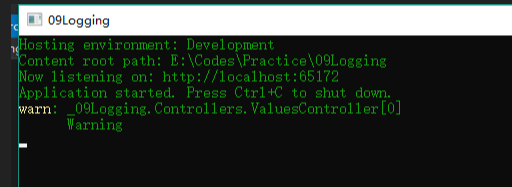您好,登錄后才能下訂單哦!
您好,登錄后才能下訂單哦!
這篇文章將為大家詳細講解有關.Net Core中的日志組件是什么,文章內容質量較高,因此小編分享給大家做個參考,希望大家閱讀完這篇文章后對相關知識有一定的了解。
1、介紹
Logging組件是微軟實現的日志記錄組件包括控制臺(Console)、調試(Debug)、事件日志(EventLog)和TraceSource,但是沒有實現最常用用的文件記錄日志功能(可以用其他第三方的如NLog、Log4Net。之前寫過NLog使用的文章)。
2、默認配置
新建.Net Core Web Api項目,添加下面代碼。
[Route("api/[controller]")]
public class ValuesController : Controller
{
ILogger<ValuesController> logger;
//構造函數注入Logger
public ValuesController(ILogger<ValuesController> logger)
{
this.logger = logger;
}
[HttpGet]
public IEnumerable<string> Get()
{
logger.LogWarning("Warning");
return new string[] { "value1", "value2" };
}
}運行結果如下:

我剛開始接觸的時候,我就有一個疑問我根本沒有配置關于Logger的任何代碼,僅僅寫了注入,為什么會起作用呢?最后我發現其實是在Program類中使用了微軟默認的配置。
public class Program
{
public static void Main(string[] args)
{
BuildWebHost(args).Run();
}
public static IWebHost BuildWebHost(string[] args) =>
WebHost.CreateDefaultBuilder(args)//在這里使用了默認配置
.UseStartup<Startup>()
.Build();
}下面為CreateDefaultBuilder方法的部分源碼,整個源碼在 https://github.com/aspnet/MetaPackages ,可以看出在使用模板創建項目的時候,默認添加了控制臺和調試日志組件,并從appsettings.json中讀取配置。
builder.UseKestrel((builderContext, options) =>
{
options.Configure(builderContext.Configuration.GetSection("Kestrel"));
})
.ConfigureAppConfiguration((hostingContext, config) =>
{
var env = hostingContext.HostingEnvironment;
//加載appsettings.json文件 使用模板創建的項目,會生成一個配置文件,配置文件中包含Logging的配置項
config.AddJsonFile("appsettings.json", optional: true, reloadOnChange: true)
.AddJsonFile($"appsettings.{env.EnvironmentName}.json", optional: true, reloadOnChange: true);
.......
})
.ConfigureLogging((hostingContext, logging) =>
{
//從appsettings.json中獲取Logging的配置
logging.AddConfiguration(hostingContext.Configuration.GetSection("Logging"));
//添加控制臺輸出
logging.AddConsole();
//添加調試輸出
logging.AddDebug();
})3、建立自己的Logging配置
首先修改Program類
public class Program
{
public static void Main(string[] args)
{
//指定配置文件路徑
var config = new ConfigurationBuilder()
.SetBasePath(Directory.GetCurrentDirectory())//設置基礎路徑
.AddJsonFile($"appsettings.json", true, true)//加載配置文件
.AddJsonFile($"appsettings.{EnvironmentName.Development}.json", true, true)
.Build();
var host = new WebHostBuilder()
.UseKestrel()
.UseStartup<Startup>()
.UseContentRoot(Directory.GetCurrentDirectory())
.UseConfiguration(config)//使用配置
.UseUrls(config["AppSettings:Url"])//從配置中讀取 程序監聽的端口號
.UseEnvironment(EnvironmentName.Development)//如果加載了多個環境配置,可以設置使用哪個配置 一般有測試環境、正式環境
//.ConfigureLogging((hostingCotext, logging) => //第一種配置方法 直接在webHostBuilder建立時配置 不需要修改下面的Startup代碼
//{
// logging.AddConfiguration(hostingCotext.Configuration.GetSection("Logging"));
// logging.AddConsole();
//})
.Build();
host.Run();
}
}修改Startup類如下面,此類的執行順序為 Startup構造函數 > ConfigureServices > Configure
public class Startup
{
public IConfiguration Configuration { get; private set; }
public IHostingEnvironment HostingEnvironment { get; private set; }
//在構造函數中注入 IHostingEnvironment和IConfiguration,配置已經在Program中設置了,注入后就可以獲取配置文件的數據
public Startup(IHostingEnvironment env, IConfiguration config)
{
HostingEnvironment = env;
Configuration = config;
}
public void ConfigureServices(IServiceCollection services)
{
services.AddMvc();
//第二種配置 也可以這樣加上日志功能,不用下面的注入
//services.AddLogging(builder =>
//{
// builder.AddConfiguration(Configuration.GetSection("Logging"))
// .AddConsole();
//});
}
//注入ILoggerFactory
public void Configure(IApplicationBuilder app, IHostingEnvironment env, ILoggerFactory loggerFactory)
{
if (env.IsDevelopment())
{
app.UseDeveloperExceptionPage();
}
//第三種配置 注入ILogggerFactory,然后配置參數
//添加控制臺輸出
loggerFactory.AddConsole(Configuration.GetSection("Logging"));
//添加調試輸出
loggerFactory.AddDebug();
app.UseMvc();
}
}這種結構就比較清晰明了。
4、Logging源碼解析
三種配置其實都是為了注入日志相關的服務,但是調用的方法稍有不同。現在我們以第二種配置來詳細看看其注入過程。首先調用AddLogging方法,其實現源碼如下:
public static IServiceCollection AddLogging(this IServiceCollection services, Action<ILoggingBuilder> configure)
{
services.AddOptions();//這里會注入最基礎的5個服務 option相關服務只要是跟配置文件相關,通過Option服務獲取相關配置文件參數參數
services.TryAdd(ServiceDescriptor.Singleton<ILoggerFactory, LoggerFactory>());
services.TryAdd(ServiceDescriptor.Singleton(typeof(ILogger<>), typeof(Logger<>)));
services.TryAddEnumerable(ServiceDescriptor.Singleton<IConfigureOptions<LoggerFilterOptions>>(new DefaultLoggerLevelConfigureOptions(LogLevel.Information)));
configure(new LoggingBuilder(services));
return services;
}接著會調用AddConfiguration
public static ILoggingBuilder AddConfiguration(this ILoggingBuilder builder, IConfiguration configuration)
{
builder.AddConfiguration();
//下面為AddConfiguration的實現
public static void AddConfiguration(this ILoggingBuilder builder)
{
builder.Services.TryAddSingleton<ILoggerProviderConfigurationFactory, LoggerProviderConfigurationFactory>();
builder.Services.TryAddSingleton(typeof(ILoggerProviderConfiguration<>), typeof(LoggerProviderConfiguration<>));
}
builder.Services.AddSingleton<IConfigureOptions<LoggerFilterOptions>>(new LoggerFilterConfigureOptions(configuration));
builder.Services.AddSingleton<IOptionsChangeTokenSource<LoggerFilterOptions>>(new ConfigurationChangeTokenSource<LoggerFilterOptions>(configuration));
builder.Services.AddSingleton(new LoggingConfiguration(configuration));
return builder;
}下面來看打印日志的具體實現:
public void Log<TState>(LogLevel logLevel, EventId eventId, TState state, Exception exception, Func<TState, Exception, string> formatter)
{
var loggers = Loggers;
List<Exception> exceptions = null;
//loggers為LoggerInformation數組,如果你在Startup中添加了Console、Deubg日志功能了,那loggers數組值有2個,就是它倆。
foreach (var loggerInfo in loggers)
{ //循環遍歷每一種日志打印,如果滿足些日子的條件,才執行打印log方法。比如某一個日志等級為Info,
//但是Console配置的最低打印等級為Warning,Debug配置的最低打印等級為Debug
//則Console中不會打印,Debug中會被打印
if (!loggerInfo.IsEnabled(logLevel))
{
continue;
}
try
{
//每一種類型的日志,對應的打印方法不同。執行對應的打印方法
loggerInfo.Logger.Log(logLevel, eventId, state, exception, formatter);
}
catch (Exception ex)
{
if (exceptions == null)
{
exceptions = new List<Exception>();
}
exceptions.Add(ex);
}
}
}下面具體看一下Console的打印實現:
首先ConsoleLogger實現了ILogger的Log方法,并在方法中調用WriteMessage方法
public void Log<TState>(LogLevel logLevel, EventId eventId, TState state, Exception exception, Func<TState, Exception, string> formatter)
{
//代碼太多 我就省略一些判空代碼
var message = formatter(state, exception);
if (!string.IsNullOrEmpty(message) || exception != null)
{
WriteMessage(logLevel, Name, eventId.Id, message, exception);
}
}
public virtual void WriteMessage(LogLevel logLevel, string logName, int eventId, string message, Exception exception)
{
.......
if (logBuilder.Length > 0)
{
var hasLevel = !string.IsNullOrEmpty(logLevelString);
//這里是主要的代碼實現,可以看到,并沒有寫日志的代碼,而是將日志打入到一個BlockingCollection<LogMessageEntry>隊列中
_queueProcessor.EnqueueMessage(new LogMessageEntry()
{
Message = logBuilder.ToString(),
MessageColor = DefaultConsoleColor,
LevelString = hasLevel ? logLevelString : null,
LevelBackground = hasLevel ? logLevelColors.Background : null,
LevelForeground = hasLevel ? logLevelColors.Foreground : null
});
}
......
}下面看日志被放入隊列后的具體實現:
public class ConsoleLoggerProcessor : IDisposable
{
private const int _maxQueuedMessages = 1024;
private readonly BlockingCollection<LogMessageEntry> _messageQueue = new BlockingCollection<LogMessageEntry>(_maxQueuedMessages);
private readonly Thread _outputThread;
public IConsole Console;
public ConsoleLoggerProcessor()
{
//在構造函數中啟動一個線程,執行ProcessLogQueue方法
//從下面ProcessLogQueue方法可以看出,是循環遍歷集合,將集合中的數據打印
_outputThread = new Thread(ProcessLogQueue)
{
IsBackground = true,
Name = "Console logger queue processing thread"public virtual void EnqueueMessage(LogMessageEntry message)
{
if (!_messageQueue.IsAddingCompleted)
{
try
{
_messageQueue.Add(message);
return;
}
catch (InvalidOperationException) { }
}
WriteMessage(message);
}
internal virtual void WriteMessage(LogMessageEntry message)
{
if (message.LevelString != null)
{
Console.Write(message.LevelString, message.LevelBackground, message.LevelForeground);
}
Console.Write(message.Message, message.MessageColor, message.MessageColor);
Console.Flush();
}
private void ProcessLogQueue()
{
try
{
//GetConsumingEnumerable()方法比較特殊,當集合中沒有值時,會阻塞自己,一但有值了,知道集合中又有元素繼續遍歷
foreach (var message in _messageQueue.GetConsumingEnumerable())
{
WriteMessage(message);
}
}
catch
{
try
{
_messageQueue.CompleteAdding();
}
catch { }
}
}
}關于.Net Core中的日志組件是什么就分享到這里了,希望以上內容可以對大家有一定的幫助,可以學到更多知識。如果覺得文章不錯,可以把它分享出去讓更多的人看到。
免責聲明:本站發布的內容(圖片、視頻和文字)以原創、轉載和分享為主,文章觀點不代表本網站立場,如果涉及侵權請聯系站長郵箱:is@yisu.com進行舉報,并提供相關證據,一經查實,將立刻刪除涉嫌侵權內容。